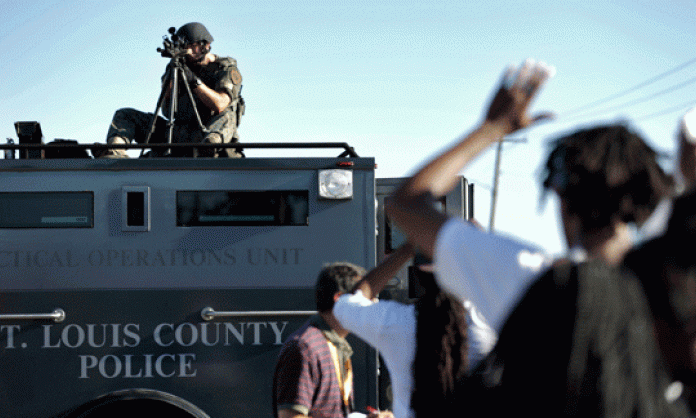Militarisation of policing is a worldwide phenomenon, largely carried out under the guise of “counter-terrorism”.
The footage coming out of Ferguson, which the police have turned into a war zone, has catapulted the issue into the mainstream.
Is camouflage gear, designed for desert and jungle combat, really necessary or effective in shopping malls and convenience stores? Why is there an armoured tank in my neighbourhood? New questions for a new era of policing. This is not unique to the US. Australian police now have all manner of sadistic, and lethal, toys to deploy against the public. There is also an arsenal of anti-protest and counter-terrorism laws to crack down on civil liberties.
Electro-shock weapons – such as cattle prods used on protesters by dictatorial regimes and electrical devices used in torture – use to get a bad rap. But in the 1990s, Taser International successfully re-branded electro-shock as a “life saver”, to be used instead of deadly force. Since then tasers have become standard police issue.
At least five people have died in Australia after being shocked by these “less-than-lethal” weapons.
Aerosol sprays are also considered “less than lethal”, although Victoria Police decided last year to replace capsicum spray with more targeted and less flammable chemical weapons due to concern about secondary exposure and fire danger associated with using it alongside tasers.
The Queensland Police Service has flagged the deployment of military-style drones during the G20 summit in Brisbane later this year. It also recently purchased Remington R4s, a military assault rifle, to be used by general duty officers. Western Australian police last year procured a $400,000 “Ballistic Engineered Armoured Response Counter Attack Truck” (known as BearCat) for “counter-terrorism”.
Criminology professor Jude McCulloch argues that counter-terrorism units set up in the mid-1970s within Australian state police forces led to the blurring of the line between the military and the police.
One of the first of these units was the Special Operations Group (SOG) in Victoria. Established in 1977, it is a paramilitary group – similar to US SWAT teams – modelled on, trained by and including former members of the SAS. Like SAS soldiers, they are trained to kill.
“Politically motivated and criminal terrorist activity” is the raison d’être for such units, but in reality these and other police tactical groups operate almost exclusively within the purview of everyday policing.
And, rather hypocritically, their real function is to carry out politically motivated violence.
On 13 October 1987, during the battle to deregister the Builders Labourers’ Federation, SOG raided and seized the union’s office in Carlton. After gaining entry, the officers cut the phone lines, ordered staff not to move and repeatedly kicked and punched an organiser when he refused to obey the order.
During protests against the World Economic Forum, held at Melbourne’s Crown Casino in 2000, the “Force Response Unit” hospitalised 30 protesters after baton charging and subjecting them to pressure point neck holds.
During the eviction of Occupy Melbourne in October 2011, “snatch squads” of officers in full Darth Vader regalia – NATO-style helmets with visors, behind transparent shields, truncheons drawn – kettled (encircled and detained) protesters for hours, sending out “search” sorties into crowds of fleeing demonstrators to make retaliatory arrests, or simply inflict some damage.
These military-style tactics have become all too recognisable at demonstrations across Australia and the world.
The militarisation of the police has nothing to do with counter-terrorism and everything to do with policing political and industrial dissent.




